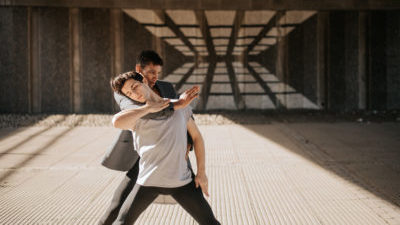This year’s SQIFF features several short film collections in its programme, one of the most popular of which proves to be Queer Scotland – a showcase for local filmmaking talent. Comprising thirteen pieces, the aesthetics and subject matters vary. However, there are several thematic through-lines including identity, appearance, expectation, and gender norms.
The opening two films, Frontiers and we were always here, both focus on dance. The former captures Scottish Ballet performers in Glasgow, cutting between different pairs (male-female, male-male, and female-female), each performing almost identical choreography and subverting expectations of gender in dance. The second film is less structured and features dancers taking over a working men’s club, strutting and vogueing to disco music. It feels rather more like a pop music video than anything else, though, and doesn’t seem to express all that much beyond this.
Animation and digital trickery are the key tools in the subsequent trilogy. Acceptable Face works with chalky, navy renderings while dissonant audio interviews play – detailing homophobia that still exists in the UK, even amongst people who might think themselves liberal or open-minded. Meanwhile, Dix Pix, as the title suggests, takes a comical yet fascinating look at the world of gay dating apps and some users’ obsessions with sending intimate photographs to strangers. It is created by our Spoken Word Editor, though, so to avoid risking impartiality, you can find out more information about his work online. Following this is the stunning 2x+xy=1, a futuristic and highly experimental piece, creating a new universe of floating cubes, kaleidoscopic waves and robotic beings, where gender has become meaningless. This film isn’t about narrative or story, but rather the creation of feeling, as we are drawn into a psychedelic, monochromatic dreamworld. The effect is hypnotic and remains a standout piece of the afternoon.
It is followed by a very different but equally affecting film: None of the Above. Here, director Siri Rødnes presents the story of a vlogger whose online dating experiment leads to disaster. A visceral sense of dread and eeriness is created as we follow fictional YouTuber Cassie towards her downfall and the brutal climax – which we are forewarned of by SQIFF – takes the ‘social media warning film’ to a new level.
The remainder of the films from here on in don’t quite reach the same level of success, though. Roberta Cowell’s Story is an amateur project that lasts only a minute, and while its subject matter is interesting, the low quality of the presentation makes us wonder why it has been included here. A Woman Is Her Most Beautiful on Her Wedding Day/Someone I Hate is another brief piece with impressive production values and an interesting topic – the false promise of happiness in traditional marriage (particularly for women) – but doesn’t quite make enough impact. Likewise, Glue is interesting enough, portraying a meeting between ex-lovers that confirms the protagonist’s thoughts and current state in life, but is also a little forgettable.
Possessive Skin and What is Happiness? come as an interesting pair, both centring on poetry recital. However, the mood created by each are almost polar opposites. Possessive Skin features trans writer/director Myles McEachan performing a sombre yet powerful piece about his experiences of isolation and segregation. What Is Happiness? then surprises us with its optimism and message that happiness is an achievable miracle, delivered through British Sign Language and accompanying joyous instrumentals.
Mini-trilogy 16mb, Future Sounds and A Mini City from director Natasha Lall, stalls proceedings, though. The opening piece offers a satirical look at the youth of the future as someone investigates an SD card they’ve uncovered in a street of the future. The joke then wears thin, though, as each of the three films essentially does the same thing, choosing a found object and imagining how it might be interpreted decades from now. It’s a quirky idea, but not enough to sustain the audience’s attention for fifteen minutes.
The anthology then closes with Crypsis, an important social film looking at the asylum process for LGBT refugees in the UK who are required to prove their sexuality in order to potentially save their lives. It’s a grim look at homophobia in other countries as well as the hypocritical and unfair system here that is failing to protect vulnerable people.
Queer Scotland is therefore a very mixed collection, and one that offers a look at some impressive talent. Although the styles vary from animation to faux-documentary to highly-produced dance pieces, all of the short films here are tied together by the idea of experimentation, boldness, and rejection of the norm. Thus, the programme is provocative and empowering.
